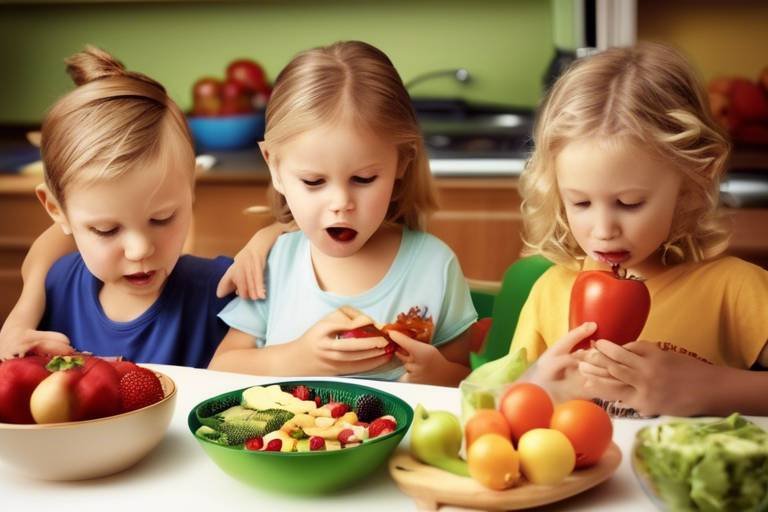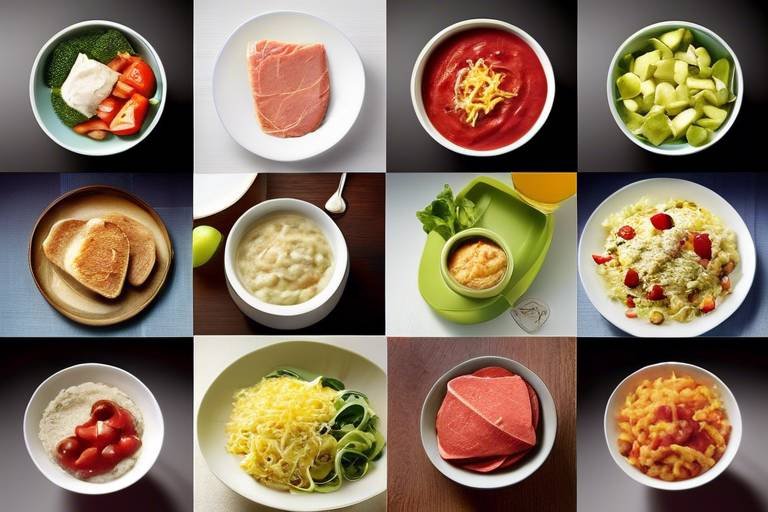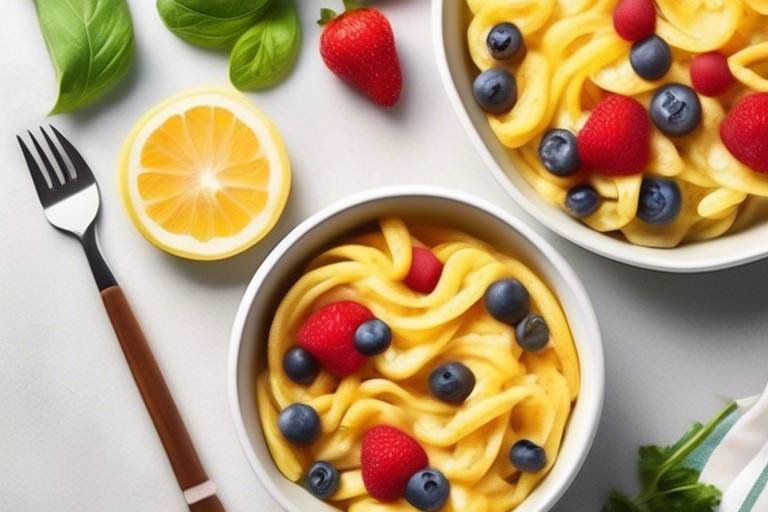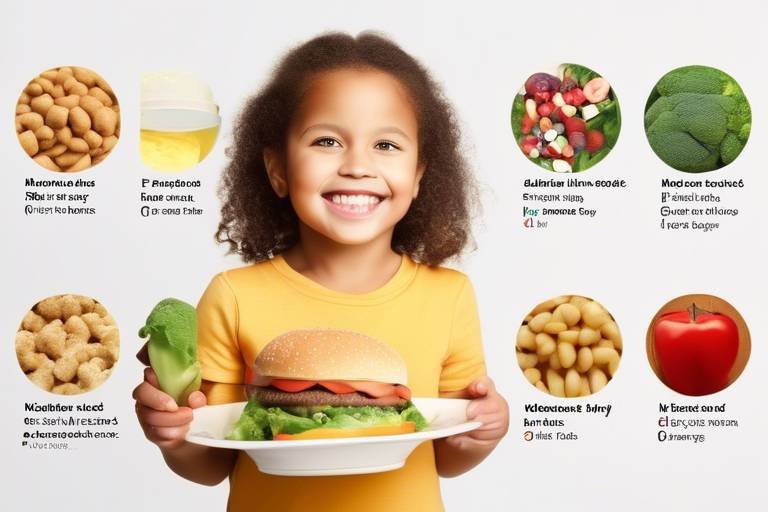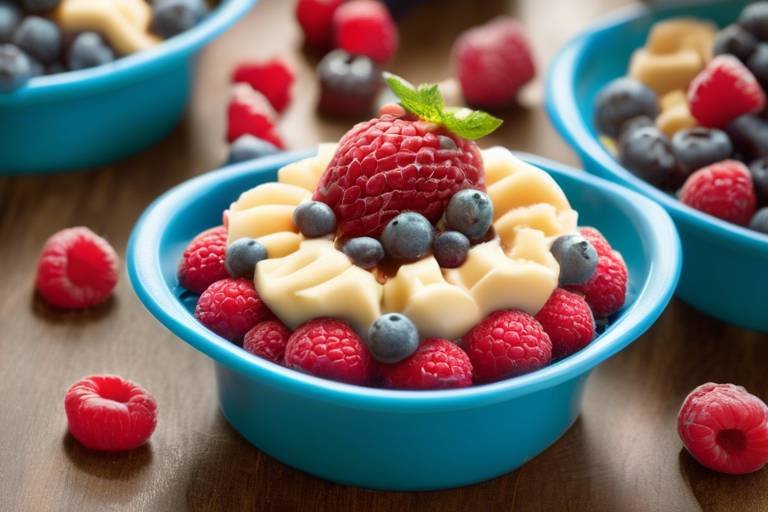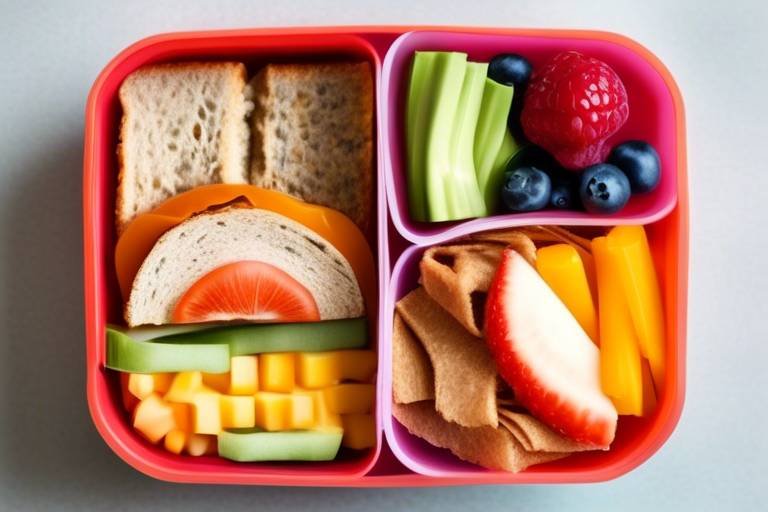Making Kid-Friendly Meals with a Nutritious Twist
As parents, we all want our kids to eat healthy, but let’s face it—getting them to enjoy nutritious meals can sometimes feel like trying to convince a cat to take a bath! The good news is that with a sprinkle of creativity and a dash of fun, you can turn healthy eating into an exciting adventure for your little ones. In this article, we’ll explore creative ways to prepare meals that not only appeal to children but also pack a nutritional punch. From sneaking in those leafy greens to making protein sources exciting, we’ve got all the tips and tricks you need to transform mealtime into a joyous occasion.
Imagine this: your child eagerly asking for seconds of their veggie-packed pasta or jumping up and down because they get to help make homemade pizza. Sounds like a dream, right? Well, it’s entirely possible! The first step is to understand the nutritional needs of kids. Children require a balanced diet rich in essential nutrients to support their growth and development. This includes a variety of vitamins, minerals, protein, carbohydrates, and healthy fats. By focusing on these key components, you can make informed decisions about what goes on their plates.
Next, we’ll dive into some creative methods to incorporate vegetables into meals. It’s no secret that many kids shy away from greens, but what if we could turn those veggies into something fun and delicious? For instance, consider the idea of vegetable smoothies. By blending fruits with a handful of spinach or kale, you can create a vibrant drink that’s not only tasty but also loaded with nutrients. Kids will love the sweetness of the fruits, and they’ll never know they’re sipping on something so healthy!
Another fantastic way to make vegetables more appealing is through colorful fruit and veggie skewers. These skewers can be a fun project for kids, allowing them to choose their favorite fruits and veggies to assemble. Picture a rainbow of colors on a stick – who could resist that? Not only do they look great, but they also encourage kids to try new foods without the pressure of a full plate. And let’s not forget about veggie-packed pasta dishes. Pasta is a kid favorite, so why not enhance it with hidden vegetables? You can blend pureed carrots or zucchini into the sauce, making it both nutritious and satisfying.
In addition to vegetables, we’ll also explore some creative protein sources that are kid-friendly. Think outside the box with options like beans, lentils, and nut butters. These ingredients can easily be incorporated into meals, providing essential nutrients without sacrificing flavor. For example, you could whip up a batch of lentil tacos that are bursting with flavor and fun, or try spreading almond butter on whole-grain toast topped with banana slices for a quick and nutritious snack.
Cooking together as a family can be a delightful experience, turning meal prep into a fun activity. When kids help in the kitchen, they’re more likely to try new foods and develop a positive relationship with healthy eating. One of the best ways to involve them is by making homemade pizza. Let them choose their toppings from a selection of healthy options, and watch as they create their own culinary masterpiece. It’s a win-win situation: they get to be creative, and you get to ensure that the meal is nutritious!
Another engaging idea is to build a balanced bento box. These Japanese-inspired lunch boxes are perfect for presenting a variety of food groups in a fun and visually appealing way. You can include whole grains, proteins, fruits, and veggies, making lunchtime exciting and nutritious. By allowing your kids to help assemble their bento boxes, they’ll be more inclined to eat what’s inside.
In conclusion, making nutritious meals that kids will love doesn’t have to be a daunting task. With a little creativity and a lot of fun, you can transform the way your children view healthy eating. So, roll up your sleeves, get ready to experiment in the kitchen, and watch as your kids discover the joy of nutritious food!
- How can I get my child to eat more vegetables?
Try incorporating vegetables into smoothies, creating fun skewers, or hiding them in sauces. - What are some good protein sources for kids?
Consider beans, lentils, nut butters, and lean meats as excellent protein options. - How can I make cooking with my kids more enjoyable?
Choose simple recipes, let them pick ingredients, and encourage creativity during the cooking process.

Understanding Nutritional Needs of Kids
When it comes to the nutritional needs of children, it’s essential to recognize that their bodies are in a constant state of growth and development. This means they require a balanced diet rich in various nutrients to support their active lifestyles. Think of a child’s body as a growing machine; just like any machine, it needs the right fuel to function optimally. So, what exactly do kids need to thrive?
First and foremost, children need a variety of macronutrients—these include carbohydrates, proteins, and fats. Carbohydrates are crucial as they provide the energy kids need to run, jump, and play. Meanwhile, proteins are the building blocks for muscles, and healthy fats support brain development. It’s like constructing a building; without a solid foundation, the structure can’t stand. In this case, a balanced intake of these nutrients creates a sturdy base for a child’s health.
In addition to macronutrients, micronutrients—vitamins and minerals—play a vital role in children's diets. These nutrients are needed in smaller amounts but are equally important for functions such as immune support, bone health, and overall development. Here are some key micronutrients to focus on:
- Calcium: Essential for strong bones and teeth. Found in dairy products, leafy greens, and fortified foods.
- Iron: Crucial for blood health and energy levels. Sources include lean meats, beans, and fortified cereals.
- Vitamin D: Supports calcium absorption and is vital for bone health. Sun exposure and fortified foods can help meet this need.
- Vitamin A: Important for vision and immune function. Carrots, sweet potatoes, and spinach are great sources.
It’s also important to consider the hydration needs of children. Water is essential for every cell in the body and helps maintain energy levels, especially during physical activities. Encourage kids to drink water throughout the day, and consider offering healthy beverages like milk or 100% fruit juice in moderation.
Lastly, it’s crucial to remember that children’s appetites can vary significantly from day to day. Some days they might eat like little birds, while on others, they could devour a feast. This variability is completely normal! The key is to offer a variety of healthy options and allow kids to listen to their hunger cues. After all, teaching children to make healthy choices is like giving them a roadmap for lifelong wellness.
| Nutrient | Function | Food Sources |
|---|---|---|
| Carbohydrates | Energy for daily activities | Whole grains, fruits, vegetables |
| Protein | Muscle growth and repair | Meat, fish, eggs, beans |
| Fats | Brain development and energy | Nuts, seeds, avocados, olive oil |
| Vitamins | Support various bodily functions | Fruits, vegetables, dairy |
| Minerals | Bone health, oxygen transport | Meat, dairy, leafy greens |
Understanding these nutritional needs is the first step toward creating kid-friendly meals that are both delicious and nutritious. By focusing on a balanced diet, you can help your children develop healthy eating habits that will last a lifetime.

Incorporating Vegetables in Fun Ways
Getting kids to eat their vegetables can often feel like trying to convince a cat to take a bath—it's a challenge! However, with a little creativity and some fun ideas, you can turn this seemingly daunting task into an enjoyable experience for both you and your little ones. The secret lies in making vegetables not just nutritious, but also exciting and appealing. Imagine transforming a plate of broccoli into a vibrant rainbow of colors that catches their eye and piques their interest. Sounds great, right? Here are some innovative strategies to incorporate veggies into your kids' meals that will leave them asking for more!
One of the most effective methods to sneak in those greens is through vegetable smoothies. These delightful drinks can be a powerhouse of nutrition while also being a fun treat. By blending fruits like bananas or strawberries with spinach or kale, you create a deliciously sweet concoction that masks the taste of the veggies. You can even let your kids help pick the ingredients, making it a fun activity! Here’s a quick recipe to get you started:
| Ingredients | Quantity |
|---|---|
| Spinach | 1 cup |
| Banana | 1 |
| Strawberries | 1/2 cup |
| Greek Yogurt | 1/2 cup |
| Milk or Juice | 1 cup |
Simply blend all the ingredients together, and voila! You've got a delicious smoothie that kids will love. But smoothies aren’t the only way to make veggies fun. Consider creating colorful fruit and veggie skewers. Kids love to eat food on a stick, and by threading pieces of bell peppers, cherry tomatoes, cucumber, and even fruits like grapes and melon onto skewers, you can create a visually appealing snack. Not only is it fun to eat, but it also encourages them to try a variety of veggies that they might otherwise overlook.
Another great idea is to enhance their favorite meals with hidden vegetables. Take pasta, for example. Most kids adore pasta, so why not sneak in some nutrition? You can puree vegetables like carrots, zucchini, or cauliflower and mix them into the sauce. This way, they won’t even notice they’re eating their greens! You can also add chopped spinach or peas directly into the pasta for an extra crunch and a pop of color. The key is to make it visually appealing and delicious, so they associate veggies with good food.
Incorporating vegetables into meals doesn’t have to be a chore; it can be a fun and interactive experience. By using creative recipes and appealing presentations, you can make vegetables a regular part of your kids' diet without the usual fuss. Remember, the goal is to create positive associations with healthy foods, so let your imagination run wild and enjoy the process together!
- How can I get my child to try new vegetables? Introduce new veggies alongside their favorites and let them help with the cooking process. Kids are more likely to try what they’ve helped prepare!
- What are some easy ways to make vegetables taste better? Try roasting vegetables with olive oil and spices, or serve them with a yummy dip like hummus or ranch dressing.
- Are smoothies a healthy option for kids? Absolutely! Smoothies can be packed with nutrients and are a great way to include fruits and veggies in your child’s diet.

Vegetable Smoothies
When it comes to getting kids to eat their vegetables, can be a game-changer. Imagine a vibrant, colorful drink that not only tastes delicious but also packs a nutritional punch! Smoothies are like a secret weapon in the battle against picky eaters. They can be made in a way that masks the taste of greens while allowing kids to enjoy a refreshing treat. Plus, the fun of blending different ingredients together can turn a mundane meal into an exciting culinary adventure!
To create the perfect vegetable smoothie, start with a solid base. You can use ingredients like spinach or kale for that nutrient boost. But wait, what if your little ones are not fans of these greens? No problem! Pair these vegetables with naturally sweet fruits such as bananas, mangoes, or berries. This combination not only enhances the flavor but also adds a beautiful color to the smoothie, making it visually appealing. Here’s a quick recipe to get you started:
| Ingredients | Measurements |
|---|---|
| Fresh spinach | 1 cup |
| Banana | 1 medium |
| Mango (frozen or fresh) | 1/2 cup |
| Greek yogurt | 1/2 cup |
| Almond milk (or any milk of choice) | 1 cup |
| Honey or maple syrup (optional) | 1 tablespoon |
Blend all these ingredients until smooth, and voilà! You have a delicious vegetable smoothie that kids will love. The best part? You can let them get creative by adding their favorite ingredients or toppings, like a sprinkle of chia seeds or a dollop of peanut butter for added flavor and nutrition.
Another fun idea is to create a smoothie bar at home. Set out various fruits, vegetables, and toppings, and let your kids build their own smoothies. This not only makes them more likely to try new ingredients but also teaches them about healthy eating in a fun and engaging way. After all, who wouldn’t want to sip on a bright green smoothie that tastes like a fruity dessert?
Incorporating vegetable smoothies into your child's diet is not just about sneaking in those greens; it’s about making healthy eating a fun and enjoyable experience. So, next time you’re looking for a quick, nutritious meal option, grab the blender and let the smoothie magic begin!
- Can I use frozen vegetables for smoothies? Yes! Frozen vegetables can be a great option as they are often picked at peak ripeness and retain their nutrients.
- What if my child doesn't like the taste of vegetables? Try adding sweeter fruits or a bit of honey to mask the taste. Experimenting with different combinations can help find a mix they love.
- How can I make smoothies more filling? Adding ingredients like Greek yogurt, nut butters, or oats can increase the protein and fiber content, making them more satisfying.

Colorful Fruit and Veggie Skewers
When it comes to making meals more exciting for kids, are a game changer! Not only do they look visually appealing, but they also offer a fun way for children to explore different flavors and textures. Imagine a vibrant array of colors on a stick, enticing your little ones to dive in and try something new. The beauty of skewers is that they can be customized to suit your child's preferences, making healthy eating feel like a fun adventure rather than a chore.
To create these delightful skewers, you can use a variety of fruits and vegetables. Think about incorporating bright bell peppers, juicy cherry tomatoes, crunchy cucumbers, and sweet pineapple chunks. The more colors you include, the more exciting the skewers will be! Kids are naturally drawn to bright colors, and by presenting fruits and veggies in this playful manner, you can spark their curiosity and encourage them to taste what they might otherwise avoid.
Here’s a simple way to assemble your skewers:
- Choose Your Base: Start with a sturdy skewer or even a fun, colorful straw as a base.
- Select Your Ingredients: Pick a mix of fruits and vegetables. For instance, you can alternate between green cucumbers, red bell peppers, yellow squash, and purple grapes.
- Get Creative: Encourage your kids to help in the assembly. Let them choose their favorite combinations and see who can create the most colorful skewer!
Not only do these skewers make for a healthy snack or side dish, but they also serve as a fantastic conversation starter at mealtime. You can even turn it into a fun game by asking them to create patterns or to guess the ingredients based on color alone. This playful approach can help children become more adventurous eaters, as they associate healthy foods with fun and creativity.
For a little extra flair, consider adding a dipping sauce. A simple yogurt dip or a light vinaigrette can take these skewers to the next level, making them even more appealing. Plus, it’s a great way to introduce new flavors without overwhelming their taste buds. Remember, the goal is to make healthy eating enjoyable, and colorful fruit and veggie skewers are a delicious way to do just that!

Veggie-Packed Pasta Dishes
Pasta is one of those dishes that almost every child loves. It's comforting, versatile, and can be dressed up in countless ways. But what if we could turn this beloved meal into a nutritional powerhouse? You might be wondering, "How can I sneak in those veggies without my kids noticing?" Well, fear not! There are plenty of creative ways to incorporate vegetables into pasta dishes, making them not only delicious but also packed with essential nutrients.
One of the simplest ways to add veggies is by blending them into the sauce. For instance, a classic marinara sauce can be enriched with pureed carrots, zucchini, or spinach. These vegetables will not only boost the nutritional value but also add a subtle sweetness that kids will love. Just imagine the surprise on their faces when they find out they’ve been devouring a dish loaded with hidden greens! You can even make a creamy Alfredo sauce healthier by mixing in some cauliflower puree. The key is to blend it well so that the texture remains smooth and appealing.
Another fun method is to create a colorful pasta salad. Use whole grain or vegetable-infused pasta as your base, and then toss in a rainbow of vegetables. Think chopped bell peppers, cherry tomatoes, and sweet corn. Not only does this add a burst of color to the plate, but it also makes the meal visually enticing. Kids are often more likely to try something that looks fun and exciting. You can even let them help with the preparation—after all, who doesn’t love a little hands-on cooking? Here’s a simple recipe idea:
| Ingredients | Instructions |
|---|---|
|
|
Don’t forget about pasta bakes! Layering pasta with veggies, cheese, and a little tomato sauce can create a hearty meal that’s perfect for family dinners. You can use ingredients like spinach, mushrooms, or broccoli to create a delightful veggie-packed dish that everyone will enjoy. Plus, it’s an excellent way to use up any leftover vegetables you have in the fridge.
Lastly, consider using different types of pasta that are made from vegetables, such as zucchini noodles or chickpea pasta. These alternatives not only add a fun twist but also provide additional nutrients and fiber. Kids might be surprised at how much they enjoy these new textures and flavors! So, the next time you're planning dinner, remember that pasta can be a canvas for creativity. With a little imagination, you can transform this classic dish into a nutritious feast that your kids will ask for again and again.
Q1: How can I make sure my child is getting enough vegetables in their diet?
A1: Incorporating vegetables into meals they already love, like pasta, is a great start. You can also involve them in cooking to make it more fun and engaging.
Q2: What are some other ways to hide vegetables in meals?
A2: You can blend veggies into sauces, add them to smoothies, or even bake them into muffins and pancakes. The key is to be creative!
Q3: Are there any specific vegetables that are more appealing to kids?
A3: Sweet vegetables like carrots, bell peppers, and peas tend to be more appealing. Roasting them can also enhance their natural sweetness.

Creative Protein Sources
When it comes to feeding kids, finding can be a game changer. Traditional protein options like chicken and beef are great, but they can get a little stale after a while. So, why not shake things up? Introducing alternative proteins not only adds variety to their diet but also opens the door to a world of flavors and textures that kids might actually enjoy! Think of it as a culinary adventure, where every meal is a chance to explore new tastes.
One fantastic way to incorporate protein is through beans and legumes. These little powerhouses are not only packed with protein but also fiber, making them a double whammy for nutrition. You can easily blend them into soups, stews, or even mash them to create delicious spreads. For example, black bean tacos can be a hit! Just mash some black beans, add a sprinkle of cheese, and let your kids build their own tacos with their favorite toppings. It’s fun, interactive, and they won’t even realize they’re eating something healthy!
Another great option is nut butters. Peanut butter, almond butter, or even sunflower seed butter can be spread on whole grain bread, used in smoothies, or drizzled over fruits. Imagine a banana sliced and smeared with almond butter, topped with a sprinkle of granola. Sounds delicious, right? It’s a simple yet effective way to get some protein into their diet while keeping it tasty. Plus, nut butters can be a great base for energy balls, which are perfect for after-school snacks.
If you’re looking for something a bit more adventurous, consider quinoa. This ancient grain is not only a complete protein, meaning it contains all nine essential amino acids, but it also cooks up fluffy and delicious. You can use it as a base for a salad, mix it into veggie burgers, or even serve it as a side dish. Kids love its unique texture, and you can easily jazz it up with colorful veggies and a splash of lemon for a refreshing twist. It’s like a party on their plates!
To give you a clearer idea of how these protein sources stack up, here's a quick comparison table:
| Protein Source | Protein Content (per 100g) | Additional Benefits |
|---|---|---|
| Black Beans | 21g | High in fiber, supports digestion |
| Peanut Butter | 25g | Rich in healthy fats, boosts energy |
| Quinoa | 14g | Gluten-free, rich in antioxidants |
| Almonds | 21g | Heart-healthy, packed with vitamins |
By incorporating these creative protein sources into your meals, you’re not just feeding your kids; you’re nurturing their bodies and helping them develop a healthy relationship with food. Plus, the more variety you introduce, the more likely they are to try new things. It’s all about making mealtime an exciting adventure that they look forward to!
Q: Are plant-based proteins as effective as animal proteins for kids?
A: Absolutely! Plant-based proteins can provide all the essential nutrients kids need. Pairing different sources, like beans with rice, can create a complete protein profile.
Q: How can I make beans more appealing to my kids?
A: Try making bean dips or adding them to their favorite dishes, like tacos or quesadillas. Mixing them with cheese or spices can also enhance their flavor.
Q: Can nut butters cause allergies?
A: Yes, nut allergies are common. If you’re introducing nut butters, do so gradually and consult with your pediatrician if you have concerns.
Q: What are some easy recipes using quinoa?
A: Quinoa salad with colorful veggies, quinoa-stuffed peppers, or even quinoa pancakes are fun and nutritious options!

Fun Cooking Activities with Kids
Cooking with kids is not just about preparing meals; it's about creating memories that last a lifetime. When you involve children in the kitchen, you open the door to a world where they can explore, learn, and most importantly, have fun! Think of it as a culinary adventure where each ingredient is a treasure waiting to be discovered. So, how do you make this experience enjoyable and educational? Let’s dive into some exciting activities that will have your little ones begging to help out in the kitchen.
One of the best ways to engage kids in cooking is to let them take charge of their meals. Imagine the joy on their faces when they realize they can create their own homemade pizza! Start by preparing a simple dough or using store-bought bases, and then lay out a variety of toppings. This could include colorful vegetables, different types of cheese, and even some lean meats. Allowing children to choose their own toppings not only gives them a sense of ownership over their meal but also encourages them to try new ingredients. Plus, who doesn’t love a pizza party?
Another fantastic activity is assembling a balanced bento box. Bento boxes are visually appealing and can be a fun way to introduce kids to portion control and balanced eating. You can set up a “bento bar” with various compartments filled with:
- Whole grains like brown rice or quinoa
- Protein sources such as grilled chicken, tofu, or hard-boiled eggs
- A rainbow of fruits and vegetables
- Healthy fats like avocado or nuts
Encourage your kids to create their own combinations, making lunchtime exciting and nutritious. This not only teaches them about balanced meals but also sparks creativity as they mix and match different flavors and textures!
Let’s not forget about the joy of baking! Baking can be a magical experience for kids, especially when they get to decorate their creations. Try making simple recipes like muffins or cookies, and then set up a decorating station with various toppings like sprinkles, chocolate chips, or dried fruits. This hands-on activity allows kids to express their artistic side while also learning about measurements and following recipes. Plus, the sweet smell of baked goods wafting through the kitchen is a bonus for everyone!
Finally, consider hosting a themed cooking night. This could be anything from “Taco Tuesday” to “Pasta Night.” Choose a theme and involve your kids in every step, from planning the menu to shopping for ingredients. This not only teaches them about different cuisines but also helps them understand the importance of meal planning and preparation. You could even turn it into a mini cooking competition, where each family member creates their own dish based on the theme. The laughter and creativity that ensue will surely make for a memorable evening!
In conclusion, cooking with kids is not just about making meals; it's about fostering a love for food and teaching valuable life skills. By incorporating fun activities like making homemade pizzas, assembling bento boxes, baking treats, and hosting themed nights, you can turn cooking into an exciting adventure. So roll up those sleeves, grab your aprons, and get ready for some delicious fun in the kitchen!
1. What age is appropriate for kids to start cooking?
Generally, children can start helping in the kitchen as early as 2 or 3 years old with simple tasks like washing vegetables or stirring ingredients. As they grow older, they can take on more complex tasks.
2. How can I make cooking safer for my kids?
Always supervise your kids while cooking, and teach them about kitchen safety. Use kid-friendly utensils and tools, and ensure they understand the importance of handling hot items carefully.
3. What are some easy recipes to start with?
Start with simple recipes like smoothies, sandwiches, or no-bake desserts. These allow for creativity without the need for complicated cooking techniques.
4. How can I encourage picky eaters to try new foods?
Involve them in the cooking process, and make meals visually appealing. Sometimes, just letting them choose their toppings or ingredients can make a big difference!

Making Homemade Pizza
There's something magical about making homemade pizza that gets kids excited! It's not just about the delicious end result; it's about the process of creating something together. Imagine rolling out the dough, spreading the sauce, and sprinkling cheese like a culinary artist. This activity can transform a simple meal into a fun family event. Plus, it gives kids the chance to express their creativity by choosing their favorite toppings. And the best part? You can sneak in some nutritious ingredients without them even noticing!
To get started, you'll need a few basic ingredients. Here’s a simple list to guide you:
- Pizza dough (store-bought or homemade)
- Tomato sauce (preferably low-sugar)
- Shredded cheese (mozzarella is a classic)
- Your choice of toppings (vegetables, meats, herbs)
Now, let’s talk about the fun part—toppings! This is where you can get really creative. Encourage your kids to choose from a variety of colorful vegetables like bell peppers, spinach, or even broccoli. Not only do these add vibrant colors to the pizza, but they also pack a nutritional punch. You can even set up a mini topping bar with small bowls of ingredients, allowing kids to customize their pizzas just the way they like them. This interactive approach not only makes the meal more exciting but also encourages them to try new foods.
Here’s a quick overview of how to assemble your homemade pizza:
| Step | Description |
|---|---|
| 1 | Preheat the oven to 475°F (245°C). |
| 2 | Roll out the pizza dough on a floured surface to your desired thickness. |
| 3 | Spread a layer of tomato sauce evenly over the dough. |
| 4 | Sprinkle shredded cheese generously on top. |
| 5 | Add your chosen toppings, arranging them in a fun and colorful way. |
| 6 | Bake in the preheated oven for 12-15 minutes or until the crust is golden brown. |
After the pizza is out of the oven, let it cool for a few minutes before slicing it up. The anticipation will build as everyone gathers around the table, eagerly awaiting their slice of creativity. Making homemade pizza is more than just a meal; it’s a chance to bond, explore flavors, and enjoy the fruits of your labor together as a family.
So, why not turn pizza night into a weekly tradition? Each week, you can try different toppings or even experiment with various sauces. Maybe one week you could go for a classic margherita, and the next, a spicy barbecue chicken pizza. The possibilities are endless, and your kids will love being a part of the process!
Q: Can I make the pizza dough ahead of time?
A: Absolutely! You can make the dough a day in advance and store it in the refrigerator. Just let it come to room temperature before rolling it out.
Q: What if my kids don’t like certain vegetables?
A: Get creative! You can blend vegetables into the sauce or choose milder options like zucchini or mushrooms that can be less intimidating.
Q: How can I make the pizza healthier?
A: Opt for whole wheat dough, use low-fat cheese, and load up on a variety of vegetables. You can also experiment with different sauces, like pesto or hummus, for added flavor without extra calories.

Building a Balanced Bento Box
Creating a balanced bento box is not just about packing food; it's about crafting a colorful, nutritious, and exciting meal that your kids will look forward to. Imagine opening a lunch box to find a delightful array of food that not only pleases the eyes but also fuels the body! A bento box can be a canvas for creativity, allowing you to mix and match different food groups while ensuring that each meal is well-rounded. So, how do you build the perfect bento box? Let’s dive into the essentials!
First and foremost, a balanced bento box should include a variety of food groups to provide the necessary nutrients for growing children. Aim to fill your bento with:
- Proteins: Think about adding grilled chicken, tofu, or hard-boiled eggs. These options are not only tasty but keep energy levels high.
- Whole Grains: Include brown rice, quinoa, or whole-grain pasta. These grains offer fiber and keep kids full longer.
- Fruits and Vegetables: A rainbow of fruits and veggies not only makes the box visually appealing but also packs in vitamins and minerals. Consider cherry tomatoes, cucumber slices, apple wedges, or berries.
- Dairy or Dairy Alternatives: Yogurt or cheese can provide calcium and protein, making them great additions.
But wait, it’s not just about what you put in the box; it’s also about how you present it! Kids are naturally drawn to vibrant colors and fun shapes. You can use cookie cutters to create star-shaped sandwiches or slice fruits into fun shapes to spark their interest. Additionally, consider using small silicone cups to separate different foods, which can make the meal feel more like a fun snack than a chore.
Here’s a quick example of how to assemble a balanced bento box:
| Food Group | Example |
|---|---|
| Protein | Grilled chicken strips |
| Whole Grains | Brown rice with sesame seeds |
| Fruits | Mixed berries |
| Vegetables | Carrot sticks and cucumber slices |
| Dairy | Yogurt with honey |
Finally, don’t forget to involve your kids in the process! When children help choose and prepare their meals, they are more likely to try new foods and enjoy what’s in their bento box. You can turn the preparation into a fun activity by letting them pick their favorite colors or shapes for their food. This not only makes mealtime exciting but also teaches them valuable skills about nutrition and cooking.
Q: How can I keep the bento box fresh until lunchtime?
A: Use an insulated lunch box or include an ice pack to keep perishable items cool.
Q: What if my child doesn’t like certain foods?
A: Experiment with different foods and presentations. Sometimes, a new shape or dip can make all the difference!
Q: Can I prepare the bento box the night before?
A: Absolutely! Preparing the night before can save time in the morning and ensure a stress-free start to the day.
By following these tips, you’ll be well on your way to creating bento boxes that are not only nutritious but also a hit with your kids. Happy packing!
Frequently Asked Questions
- What are some essential nutrients that kids need?
Kids require a variety of nutrients for proper growth and development. Key nutrients include protein for muscle growth, calcium for strong bones, iron for healthy blood, and vitamins A and C for immune function. By ensuring a balanced diet rich in these nutrients, parents can support their children's overall health.
- How can I encourage my kids to eat more vegetables?
Making veggies fun is the secret! Try incorporating them into smoothies, creating colorful fruit and veggie skewers, or adding hidden veggies to pasta dishes. When kids see their favorite foods mixed with veggies, they are more likely to give them a try!
- What are some kid-friendly protein sources?
Instead of traditional meats, consider introducing beans, lentils, and nut butters. These alternatives are not only nutritious but can also be delicious when prepared creatively. For instance, lentil tacos or peanut butter smoothies can be a hit!
- How can cooking together make kids more interested in food?
When kids participate in cooking, they feel a sense of ownership over their meals. Activities like making homemade pizza or assembling bento boxes allow them to choose their ingredients and experiment, making them more likely to try new foods.
- What are some ideas for a balanced bento box?
A balanced bento box can include a mix of food groups:
- Fruits: Sliced apples or berries
- Vegetables: Carrot sticks or cucumber slices
- Protein: Hummus or turkey slices
- Grains: Whole grain crackers or rice



